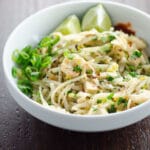Easy Pad Thai Recipe
Here's a beautifully balanced, super-flavorful, easy pad Thai recipe that you can make at home in less than half an hour. Don't miss it.
Calories: 508kcal
Ingredients
- 8 ounces (227 grams) stir-fry rice noodles
- ¼ cup (50 grams) brown sugar
- ¼ cup (60 ml) fish sauce
- 2 tablespoons (30 ml) unseasoned rice vinegar
- 2 tablespoons (30 ml) freshly squeezed lime juice
- 1 tablespoon (15 ml) tamarind paste
- ¼ teaspoon red pepper flakes
- 3 tablespoons (45 ml) safflower oil
- 1 medium shallot minced
- 2 garlic cloves minced
- 8 ounces (227 grams) small shrimp
- 3 ounces (85 grams) baked tofu, diced (see note 6 below)
- 2 cups mung bean sprouts
- 2 eggs
- 3 scallions sliced
- ½ cup chopped fresh cilantro
- ½ cup chopped roasted peanuts
- Lime wedges for serving
- Sriracha for serving
Instructions
- Place noodles in a large bowl or baking dish and cover with boiling water. Let sit for 10 minutes, stirring occasionally. Prepare the rest of the ingredients while the noodles soften.
- In a small mixing bowl, stir together the brown sugar, fish sauce, rice vinegar, lime juice, tamarind paste, and red pepper flakes.
- Heat two tablespoons of the oil in a wok or 12-inch nonstick skillet over medium-high.
- Add shallot and garlic and stir-fry for about two minutes, until very fragrant.
- Add shrimp and cook, stirring only once or twice, until just opaque, a couple of minutes.
- Drain noodles and add to pan with some water still clinging to them.
- Pour in sauce and cook, stirring frequently, until noodles are tender and sauce has thickened enough to cling to noodles without any excess liquid in the pan.
- Stir in tofu and bean sprouts.
- Push the pad thai to sides of the pan to create some space in the center.
- In the well you created, heat the remaining tablespoon oil and crack in the eggs. Break the yolks but otherwise leave eggs to set on the bottom.
- After a minute or two, scramble the eggs a bit to just cook through, leaving whites and yolks distinct.
- As soon as eggs are cooked, remove pan from heat and stir eggs into noodle mixture.
- Stir in scallions, cilantro, and peanuts, reserving some to garnish if you like.
- Divide among shallow bowls and serve with lime wedges and sriracha.
Notes
- The base of this recipe is the dried, flat rice noodles called rice sticks. Rice sticks come in several widths — for pad thai you'll want the medium width. They're sold under various names, which also include pad thai noodles, banh pho, and sometimes even linguine.
- I've called for brown sugar because it's easy to find. Palm sugar is more traditional. If you have it in your pantry, you can use an equal amount of that instead.
- At least in the U.S., tamarind concentrate and tamarind paste are typically the same product — a thick, syrupy, pourable, reduction with a concentrated flavor. Keep it in the refrigerator for a super-long shelf life.
- Safflower oil is my high-smoke-point, neutral-tasting vegetable oil of choice. You can substitute another oil that has similar properties, such as canola, sunflower, peanut, corn, or vegetable oil blend.
- Small wild shrimp from the freezer section are perfect here. They're less expensive than larger shrimp and easier to eat and to distribute throughout the dish. I like to buy them peeled and cleaned, either with tails on or off.
- I like to make this recipe with teriyaki-flavored baked tofu from the refrigerator section of the supermarket. If you prefer, you can start with plain extra-firm tofu. Use half of a standard 14-ounce block. Press it well between layers of paper towel or lint-free kitchen towel to remove excess moisture. Dice into ½-inch pieces and press again. Add to the pan between steps 4 and 5 above and cook, stirring occasionally, until lightly browned on most sides before adding the shrimp.
- Fresh mung bean sprouts can be hard to find at times due to their very short shelf life, so canned is absolutely fine here too if that's what you've got. If using canned ones, drain, rinse well, and shake dry before adding to the pan. The contents of one standard 14-ounce can is close enough to the two cups called for in the recipe.
- Like most stir-fry dishes, this easy pad thai recipe comes together quickly and easily and is at its best shortly after cooking. I don't recommend making it in advance. That said, leftovers keep well in an airtight container in the fridge for a week and can be reheated with a quick stint in the microwave.
Sourcing your ingredients
If you have a local Asian market, you should be able to find all the ingredients there. Some large supermarket chains also carry all or most of these products. Or you can order online:Suggested variations
- To make this recipe vegetarian, double the tofu, omit the shrimp, and use a vegetarian fish sauce substitute.
- To make it vegan, use the vegetarian adaptation and also omit the egg or use a plant-based egg replacement.
- Instead of the shrimp, you could use chicken or pork. This is a great place for leftovers, or thinly slice and cook the meat right in the pan where the recipe calls for adding shrimp.
Nutrition
Calories: 508kcal | Carbohydrates: 48.4g | Protein: 20.9g | Fat: 27.1g | Fiber: 4.2g
